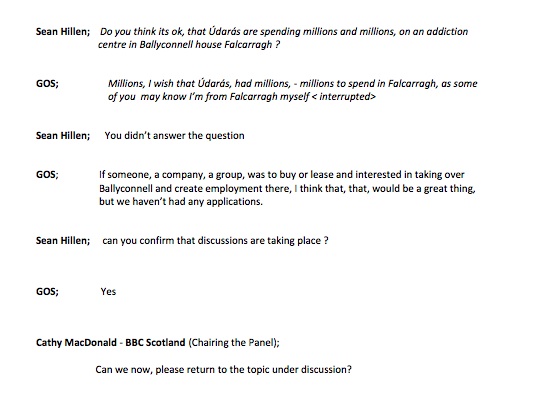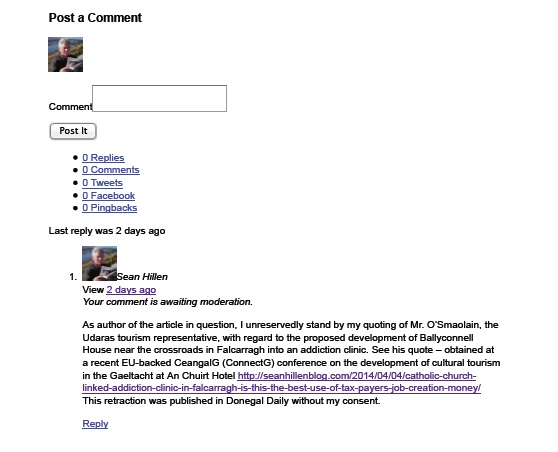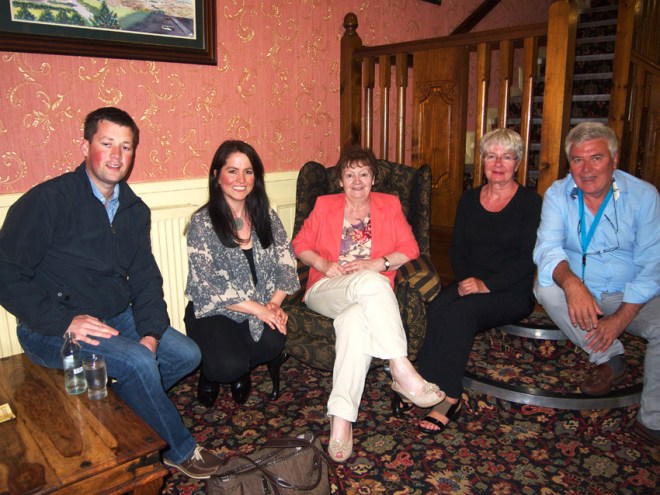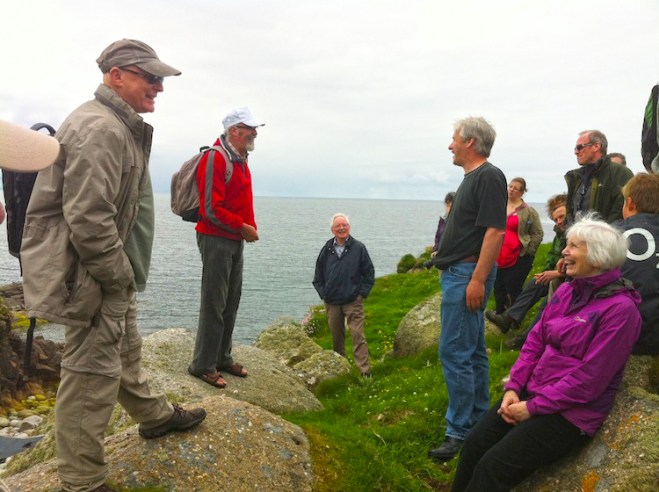Sitting in the front row at a CeangalG (ConnectG) conference on cultural tourism at An Chuirt Hotel a few weeks back I took the opportunity to ask Udaras representative, Gearoid O’Smaolain, about his organization’s plans for a drug addiction clinic in Falcarragh.
As seems traditional policy with Udaras (a characteristic that has led to its acquiring the sobriquet ‘the Secret Society’), the organization’s local tourism official was reluctant to talk, but I persevered and asked him three separate questions on an issue that I consider is of strong importance to the local community. Ultimately, the response I eased out was that Udaras had received no decent proposals over the years for Ballyconnell House near the crossroads of the west Donegal town and was in advanced negotiations to turn it into a drug addiction clinic. This information was included in one of my stories, “Catholic church linked addiction clinic in Falcarragh – Is this the best use of tax payers job creation money?”
Imagine my surprise when I received a phone call from Stephen Maguire, who established the ‘Donegal Daily’ news service with Brenda O’Neill, where my story on the addiction clinic had been published, saying he had received the following email from Mr. O’Smaolain:

Until Mr. Maguire’s phone call and even though my name was clearly on the article, I had not received any communication from Mr. O’Smaolain about any alleged misquote, not even after I asked Mr. Maguire to have him contact me to discuss the matter (Having once been the beneficiary of my dear wife’s delicious ‘Columbian’ cooking as a guest at my home for lunch, there didn’t seem any valid reason for Mr. O’Smaolain to have been too shy about contacting me).
After many years in journalism, including working for The Irish Times, Time magazine and the Daily Telegraph, the United Nations Media Centre in New York, as well as founder and publisher of a national media and events company in Eastern Europe for ten years, I hope I have developed the right skills to compile an accurate story from an event. However, we are human, mistakes happen, so I asked Mr. Maguire what Mr. O’Smaolain said he had said.
This is where things began to take on a veneer of surrealism.
Mr. Maguire received from Mr. O’Smaolain what was alleged to be a ‘transcript’ of the Q&A we had at the conference and a private conversation I had with Mr. O’Smaolain afterwards. I found this to be surprising as I had been informed by the event organisers that there was no official transcript of the conference. And certainly, nobody tape-recorded the private conversation between us both, immediately afterwards. Also, as I was in the front row not ten yards away, directly facing Mr. O’Smaolain, I doubt very much if I misheard what he said, and I told Mr. Maguire as much (My Teeline shorthand learned at postgraduate journalism school at City University, London, is also pretty darn good. I may even proudly have reached the magic 100 words per minute back then).
When Mr. Maguire called me I was in Sicily (ironically visiting a cultural tourism project) so I asked him to e-mail me the so-called ‘transcript’ and I would respond when I got back to my hotel that evening. The ‘transcript’ is alleged to have been written by Mrs. Cathy MacDonald, the person who chaired the panel meeting Mr. O’Smaolain was on.

But the so-called ‘transcript’ of the Q&A is quite porous indeed, not surprising, considering the fact that it is never easy to do ‘double duty,’ meaning take comprehensive notes while chairing a four-person, panel discussion (for example, it is truly amazing to read above that while she is speaking at the event, she is writing at the same time). And, as I had learned a week or so earlier from Udaras HQ Galway that it had spent around 2.2 million euro last year in Donegal, I would hardly have used the term “millions and millions” in relation to one project (it also strikes me as simplistic ‘baby talk’).
Stranger still, while I had quoted Mr. O’Smaolain saying there had been no “decent proposals” for Ballyconnell House since Udaras took it over many years ago, his so-called ‘transcript’ shows him saying there had categorically been “no” applications at all. Coincidently, a week or so before the CeangalG conference, on a bus journey to Letterkenny, a well-respected Gortahork-based businessman, Milo Butler, in the seat beside me, told me he had submitted a comprehensive proposal for a tourism complex including an equestrian centre to Udaras for Ballyconnell House, a statement he reiterated with much anger when we met in Falcarragh later and I told him what Mr. O’Smaolain had said. Anger is a natural, indeed justifiable, response from anyone who has, in effect, being called a liar. Even stranger still, in an e-mail I received yesterday from Siubhan Nic Grianna, national communications and marketing manager for Udaras, she indicates there indeed were some proposals submitted for Ballyconnell House to her organisation. But more on this in a future post.
After e-mailing both myself and Mr. O’Smaolain saying:

‘Donegal Daily’ then removed the article on the addiction clinic from its news site, as well as more than 240 ‘shares’ from readers.
I was not pleased, of course, as by doing so, Mr. Maguire was leaving himself open to criticisms of infringing on freedom of expression, but as a former publisher, I also could picture the kind of pressure Mr. Maguire might be under from the powers that be.
Imagine my utter anger, however, when I woke next morning, without any further communication from Mr. Maguire, to read the following on the ‘Donegal Daily’ news site:

I, of course, tried to reach Mr. Maguire by phone and e-mail from Sicily seeking a full explanation, asking what, if any, new information had come to light. There was no response. I contacted him again several days later, sending him another e-mail. As of the time of publishing this blog article, more than a full week later, I still have not received any response from him addressing any of my questions regarding the reasons for his actions – be that legal, editorial or simply financial, meaning Udaras or bodies/individuals associated with Udaras either threatening tacitly or overtly him as an individual or Donegal Daily Ltd. as a company to withdraw advertising, or promised future revenue such as grants. (I note that Udaras board member and Fine Gael local council candidate, John Curran, ran an advertising campaign on ‘Donegal Daily’ plus stories but I would be severely disappointed if he had interfered in freedom of the press or freedom of expression issues in any way – two avenues, I notice, he himself availed of when he promptly favorited the ‘Donegal Daily’ clarification on social media outlets).
Confusing matters further is the fact that the ‘Donegal Daily’ statement was headlined ‘clarification’ not ‘correction,’ so in an effort to clarify matters for readers and respond to the retraction published without my consent, I submitted the comment below to ‘Donegal Daily.’

It declined to publish it and even deleted it from its Facebook. Hardly an action supporting freedom of expression.
Note
After more than 30 years in journalism, some spent in the tough world of investigative journalism, I have learned there is one sure-fire rule: if the people/institution you are writing about cannot ‘deal’ with a particular story (due to its veracity and its controversial nature), they will inevitably attempt to ‘deal’ with the storyteller, usually through accusations of bias or/and professional ineptness.
Ultimately it is sad this episode has come to pass. For more than a year, I have tried through the normal accepted means open to citizens to obtain information from Udaras, locally and nationally, and indeed directly from Mr. O’Smaolain, through phone calls, e-mails and FOI requests, without receiving sometimes as much as the professional courtesy of a response, never mind the information I’ve requested. If I had, there would have been no need to ask Mr. O’Smaolain at a CeangalG public forum.
It must be remembered, Udaras is a public body, supported by your money, the national purse. As such, it should share openly – not hide secretively – details about how it is spending what is a very precious commodity these days. As the most recent scandal at Rehab and others before it have shown, ordinary people in Ireland have already suffered enough from lack of transparency and proper accountability in public and semi-public bodies.
I welcome your views, either through comments below or the contact page.
























































